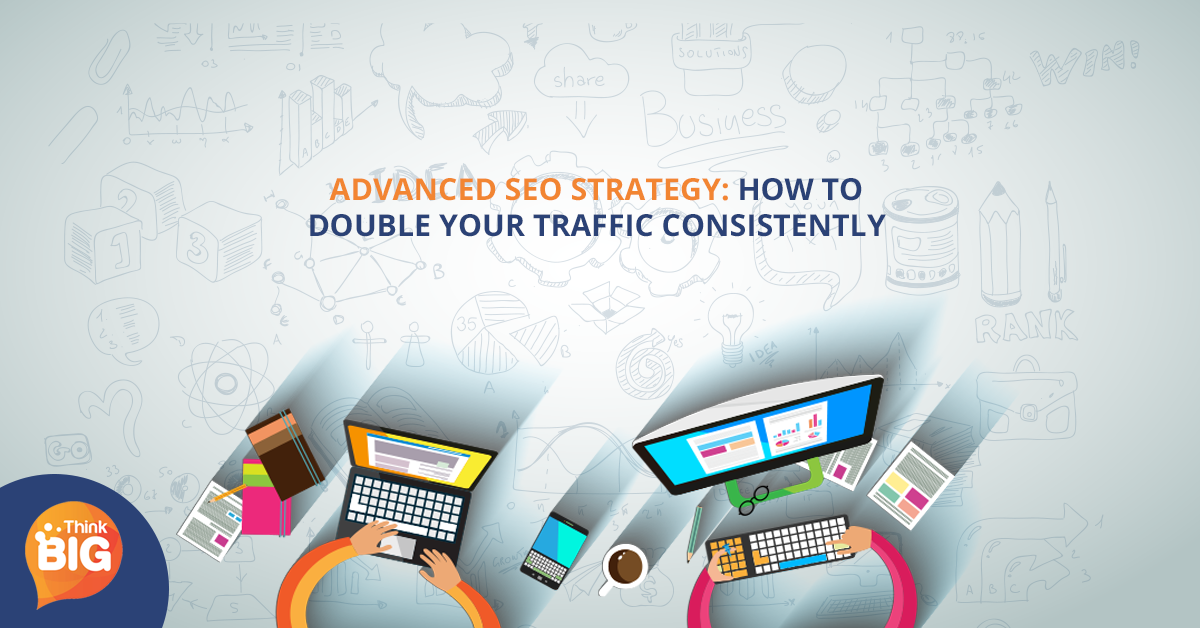
Let’s assume that this isn’t your first week in the world of SEO.
If you’ve been in the world of SEO for some time, there’s a good chance you already have a basic grasp of some key concepts.
For example, we don’t have to spend much time discussing keywords or the difference between internal links and external links.
But interestingly enough, the more experienced business owners are the ones that end up struggling when it comes to driving consistent growth.
Which makes sense, if you stop and think about it.
If you’re completely new to the world of SEO, there’s plenty of room for growth. And frankly, there’s a big difference in traffic between a site with no SEO and a site that’s been somewhat optimized.
But the bigger your site gets, and the more experience you have with SEO, the harder it can be to identify that ‘weak link’ that’s holding your site back.
That’s why today, we’re going to take some time to discuss advanced SEO strategy.
Specifically, we’re going to cover some of the tactics you’ll need if you’re looking to increase website traffic and drive more conversions to your site.
By the time we’re done here, you’re going to be armed with the tools and knowledge you need to increase website traffic, conversions, engagement, and turn your site into the online authority it was meant to be.
1. SEO Audit Your Entire Site

Before we can start applying any new techniques or strategies, we need to understand what’s broken.
When done properly, an SEO audit should reveal why you’re not getting the traffic and conversions you want.
You could hire an SEO company to do this for you, but you’ll save a pretty penny doing it yourself.
More importantly, auditing your own site will help you become familiar with all the different SEO components much faster.
Not a bad deal, right?
So, assuming this is your first SEO audit, there are a few things to keep in mind.
If you’re wondering whether or not your site actually needs to be reviewed this intensely, answer the following questions:
- Does every single page on your website have both meta titles and meta descriptions?
- Are each of those pages also optimized for keywords and mobile?
- Has your URL structure been optimized for search engine algorithms?
If you answered “no” to any of those questions, your site is in desperate need of a tune-up if you want to increase website traffic.

Not because it’s some sort of eyesore or UX nightmare. It’s just that when your on-site SEO isn’t top-notch, you’re putting your website’s success in the hands of your competition.
If they chose to ignore their on-site SEO, you’re in the clear.
If they didn’t? Well, let’s just say you’re going to have a bad time.
And even if you answered “yes” to all those questions, your site still needs to apply each of the tactics in this list if you want to become a true online authority.
2. Content Curation Done Right

Whenever people talk about content curation, there’s a particular formula that people follow.
Content curation typically takes place on social media, as a way of posting without having to create new content.
On the surface, there’s nothing wrong with that approach.
Most brands and businesses can’t be expected to create new blog posts every single time they post on Twitter, Facebook or LinkedIn.
But what brands end up with is typically just a reference to another site with some interesting story or stats. There’s a bit of ‘brand authority by proxy’ happening, but it’s horribly shallow.
In reality, the best way to curate content is to outshine the competition.
Confused? Here’s what we mean.
Let’s imagine there are two companies: Brand A and Brand B.
Both wake up one morning and learn about a new, interesting statistic in their industry.
Brand A decides to Tweet about it, with a link back to the original poster and maybe a few words of commentary.
But Brand B decides to step things up a bit.
Instead of just regurgitating what they read that morning, the savvy people at Brand B decided to build a brand new piece of content with this statistic at its center.
They then promote their new piece of content on social.
You can probably guess which Tweets drove more engagement.
You can’t expect to reach the top of the digital marketing food chain by doing the bare minimum. If you have the chance to take something good and make it great, you should.
3. Create High-Value Content

If we’re being honest, this is the tactic that most brands struggle with when it comes to SEO.
Why? Because some business owners think that content marketing and SEO are somehow competing strategies.
The truth is that in the world of digital marketing, nothing operates at its best in a vacuum.
Having a site with great SEO and terrible content likely means you’re going to end up with decent traffic but a massive bounce rate.
And having a site with strong content and awful SEO means that you’re not going to be able to drive enough traffic to your site to make it worthwhile.
If you want to drive traffic to your site and increase website traffic and your conversion rate, you need to see SEO and content marketing as two sides of the same coin.
So, with that in mind, let’s talk about how to create the best kind of content for SEO.
There’s no getting around the fact that your content has to be highly valuable to your audience.
Whenever you’re creating a piece of content, ask yourself: “can readers find something this useful anywhere else online?”

If not, congratulations! You’re on the right track.
But that leaves us with another question — what does it mean to be uniquely valuable?
For the sake of simplicity, let’s look at utility from two general perspectives: tangible solutions and thought leadership.
When you’re offering readers tangible solutions, you’re taking your understanding of audience pain points and your industry experience and giving readers something actionable.
Offering readers tangible solutions to their problems is great for people who want their immediate needs met, and that’s worth its weight in gold when you’re becoming an online authority.
But that’s hardly the only kind of value-driven content you can create.

Depending on your demographic, you can create thought leadership content.
If you’re at all confused about thought leadership, think of it as your way of addressing the illness instead of the symptoms.
Let’s say you work in a particularly complex industry. There’s a good chance that you could ‘spot-correct’ every mistake your readers are making, and they’d still struggle somehow.
Typically that’s because their approach is fundamentally flawed. Or to put it more bluntly, the way they think about your industry just isn’t accurate.
And that’s okay! Your content is here to help them. But instead of trying to course-correct them indefinitely, it may be time to create a few pieces of content that get them thinking about your industry properly.
These two types of content can be enough to create a dynamite marketing strategy, provided that the rest of your on-site SEO is properly maintained.
Speaking of on-site, let’s talk about internal links and why so many businesses use them the wrong way.
4. Topic Clusters and Internal Links

Here’s the thing about internal links. For whatever reason, business owners tend to think of them as a UX issue.
And to a certain extent, they’re not wrong. If you want to make sure your site is easy to navigate, properly managing your internal links is a great place to start.
But there’s so much more to internal links than just facilitating the user experience.
Enter the world of topic clusters.
If you’re unfamiliar with the concept of topic clusters, here’s the easy way of imagining it.
Google’s search engine is not interested in helping businesses. It only cares about one thing: giving users the most appropriate, high-value response to their searches.
That’s why instead of having 10 articles that all fight for their own spot on the first page of Google, you have 9 articles boosting a single flagship article’s signal.
Each of those booster articles have internal hyperlinks to the flagship article, and that clearly conveys to Google that your flagship article is worth paying attention to.
Frankly, it’s a simple way to take your in-depth understanding of a particular topic and increase the probability that your content will be noticed by Google’s picky algorithm.
5. Earn/Build Backlinks

Remember what we said earlier, about how Google was looking for high-value responses?
Well, backlinks are one of the ways that Google determines which pages have the most online authority.
And make no mistake: becoming an online authority is the end game, especially if you want to drastically increase website traffic and your conversion rate and drive more traffic to your site.
That being said, the concept of backlinks is an interesting one because quite a few business owners think that this process is completely out of their hands.
And that couldn’t be further from the truth.
You can (and should) take charge of your backlink status, starting with broken links.
The technique is simple enough. You start by getting in touch with a webmaster or site manager, reporting the relevant broken links to them.
In the same breath, you should recommend some other sites they should use to replace those links.
More specifically, yours.

Sites like Wikipedia are a great place to start, with tons of traffic and an audience desperate for some high-quality content.
But if you were hoping to expand the net, you’ll want to type the following into Google:
- [keyword]+links
- [keyword]+resources
- [keyword] inurl:links
If that doesn’t seem up your alley, no need to worry. Broken links are far from the only way to earn backlinks.
One of our personal favorites? The backlink via infographics.
Whether you like them or not, infographics are some of the most popular forms of content as far as traffic and backlinks are concerned.
Everyone loves visual content, and infographics manage to take stuffy statistics and analysis and make it fun.
No good at graphic design? Not a problem. You can usually hire a graphic designer for about $200 (provided you’ve done all the research).
Conclusion to Increase Website Traffic

Here’s the bad news: even with all these tweaks, your traffic isn’t going to double overnight. The nature of true online authority is that it takes time to develop.
But don’t let the journey scare you away. The truth is that if you’re auditing your site and looking for new ways to drive traffic to your site, you’re already halfway there.
When it comes to content curation, focus on finding content that your audience cares about, then create a uniquely valuable piece of content yourself.
As for the actual content itself, consider whether or not it’s actually value-driven. Your content should either be solving your audience’s immediate problems or helping them understand some greater theme within your industry.
Take the time to build links internally and create topic clusters, making it easier for Google’s algorithm to find your flagship content.
And go a step beyond when it comes to building backlinks, using every trick in the book to boost your site’s signal and become a genuine online authority.
It may not be easy, but once you’ve armed yourself with these techniques and tactics, it’s only a matter of time before you’re able to boost your engagement and increase website traffic on your website.

